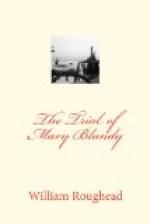INTRODUCTION.
In the earlier half of the eighteenth century there lived in the pleasant town of Henley-upon-Thames, in Oxfordshire, one Francis Blandy, gentleman, attorney-at-law. His wife, nee Mary Stevens, sister to Mr. Serjeant Stevens of Culham Court, Henley, and of Doctors’ Commons, a lady described as “an emblem of chastity and virtue; graceful in person, in mind elevated,” had, it was thought, transmitted these amiable qualities to the only child of the marriage, a daughter Mary, baptised in the parish church of Henley on 15th July, 1720. Mr. Blandy, as a man of old family and a busy and prosperous practitioner, had become a person of some importance in the county. His professional skill was much appreciated by a large circle of clients, he acted as steward for most of the neighbouring gentry, and he had held efficiently for many years the office of town-clerk.
But above the public respect which his performance of these varied duties had secured him, Mr. Blandy prized his reputation as a man of wealth. The legend had grown with his practice and kept pace with his social advancement. The Blandys’ door was open to all; their table, “whether filled with company or not, was every day plenteously supplied”; and a profuse if somewhat ostentatious hospitality was the “note” of the house, a comfortable mansion on the London road, close to Henley Bridge. Burn, in his History of Henley, describes it as “an old-fashioned house near the White Hart, represented in the view of the town facing the title-page” of his volume, and “now [1861] rebuilt.” The White Hart still survives in Hart Street, with its courtyard and gallery, where of yore the town’s folk were wont to watch the bear-baiting; one of those fine old country inns which one naturally associates with Pickwickian adventure.
In such surroundings the little Mary, idolised by her parents and spoiled by their disinterested guests, passed her girlhood. She is said to have been a clever, intelligent child, and of ways so winning as to “rapture” all with whom she came in contact. She was educated at home by her mother, who “instructed her in the principles of religion and piety, according to the rites and ceremonies of the Church of England.” To what extent she benefited by the good dame’s teaching will appear later, but at any rate she was fond of reading—a taste sufficiently remarkable in a girl of her day. At fourteen, we learn, she was mistress of those accomplishments which others of like station and opportunities rarely achieve until they are twenty, “if at all”; but her biographers, while exhausting their superlatives on her moral beauties, are significantly silent regarding her physical attractions. Like many a contemporary “toast,” she had suffered the indignity of the smallpox; yet her figure was fine, and her brilliant black eyes and abundant hair redeemed a face otherwise rather ordinary. When to such mental gifts and charm of manner was added the prospect of a dower of ten thousand pounds—such was the figure at which public opinion put it, and her father did not deny that gossip for once spoke true—little wonder that Mary was considered a “catch” as well by the “smarts” of the place as by the military gentlemen who at that time were the high ornaments of Henley society.




